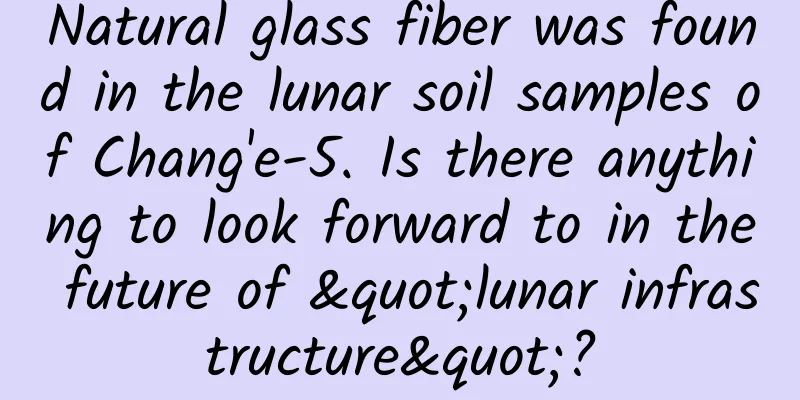Natural glass fiber was found in the lunar soil samples of Chang'e-5. Is there anything to look forward to in the future of "lunar infrastructure"?

|
Glass is a very common substance on Earth. From window glass to polymer plastics; from glasses to microscopes and magnifiers commonly used in laboratories; from communication optical fibers to mobile phone panel glass, glass is widely used. But did you know that there is also a lot of glass on the moon? In December 2020, China's Chang'e-5 lunar probe brought back 1.7 kilograms of lunar soil from the moon, and found that the glass in it accounted for about 16% (1/6) of the lunar soil minerals. In particular, a research team from the Institute of Physics of the Chinese Academy of Sciences recently discovered natural glass fibers in the lunar soil. These discoveries are of great significance to the future construction of lunar bases and the study of the lunar evolution history. You must be curious, is the glass on the moon the same as the glass on Earth? To be precise, they are not exactly the same. The types of glass on the moon are more diverse. There are three main reasons for its formation: The first is the melt or gas ejected by a volcano, which cools and turns into glass; The second is the melt and gas produced by the intense heating during the meteorite impact, which cools and turns into glass; The third is due to long-term radiation from solar wind, which can also turn the surface of mineral particles into glass. The lunar glass obtained by solidifying the melt can have a relatively large size; while the glass formed by high-temperature steam condensation or solar wind radiation is generally a thin film, so the surface of many lunar soil minerals is covered with a layer of glass armor. 1. What does it mean that China has discovered natural glass fiber in lunar soil? We know that glass fiber has important application value in many fields due to its special mechanical and optical properties, such as strengthening buildings, communication optical fiber, etc. However, not all glass can be made into fibers. Only when the specific viscosity and surface tension conditions are met can the glass melt be made into fibers. The discovery of natural glass fiber on the moon at least shows that lunar soil minerals are suitable for the preparation of glass fiber, which provides an important material basis for the construction of a lunar base in the future. 2. In the future, humans can use lunar glass in many fields. For example, building load-bearing materials: On the one hand, glass is relatively strong, and its fracture strength can reach 2-3 times that of steel; on the other hand, it has good molding ability and can be made into almost any shape; and its solid-liquid transition temperature is low, so it can use concentrated sunlight to melt the lunar soil and build lunar glass buildings based on 3D printing methods. Whether it is glass balls or glass fibers, they can increase the strength of buildings, especially lunar glass fibers, which have been relatively maturely applied in composite materials. If you print an all-glass building, it can also have a warming effect of the greenhouse effect and resist solar wind radiation. Glass can also be used to make optical materials : for example, it can be used to prepare optical fibers, providing the basis for communications between future lunar bases. In addition to these direct uses, it also has some unexpected values . Because glass has a very high stability, it can preserve some volatile substances from long ago, just like amber glass can preserve biological specimens for millions of years. There are many treasures sealed in the lunar soil glass - for example, our team from the Ningbo Institute of Materials, Chinese Academy of Sciences, discovered that a large amount of helium-3 resources in the form of bubbles are stored in the surface glass of ilmenite. Helium-3 is a key refrigerant required for many cutting-edge research projects. Helium-3 is also an important nuclear fusion energy material with a high energy efficiency and no neutron radiation. Lunar soil glass can also be used as a time clock to estimate geological ages. Recently, a joint team from the Institute of Physics of the Chinese Academy of Sciences and the Songshan Lake Materials Laboratory found that the elastic modulus of lunar glass is more than 70% larger than that of conventional glass, and this data can be used to estimate geological ages. In addition, lunar soil glass also contains a lot of hydrogen and water, which can provide energy and water for future lunar bases. Therefore, we look forward to more and more achievements and discoveries in the study of lunar glass, which will contribute to the construction of future lunar bases and promote the exploitation and use of strategic lunar resources. Thank you! This article is a work supported by the Science Popularization China Starry Sky Project. Author: Wang Junqiang, Researcher at the Ningbo Institute of Materials Technology and Engineering, Chinese Academy of Sciences Reviewer: Zuo Wei, researcher at the National Astronomical Observatory of the Chinese Academy of Sciences Produced by: China Association for Science and Technology Department of Science Popularization Produced by: China Science and Technology Press Co., Ltd., Beijing Zhongke Xinghe Culture Media Co., Ltd. |
<<: How do we differentiate between storks, cranes and herons, all of which are very elegant?
Recommend
Scientists have given the newly discovered pangolin a temporary name of "mysterious", and you may never guess why...
Not long ago, the team led by Professor Yu Li fro...
You may be eating these five types of foods that cause inflammation every day! Reminder →
Many diseases that plague the human body All have...
The efficacy and function of water sedge
Water grass is one of the common traditional Chin...
What is the correct way to consume Maca powder?
We all know that once male friends have impotence...
The efficacy and function of duck feet yellow edge
The environment is now seriously deteriorating an...
How much is the dosage of Gynostemma pentaphyllum tea?
Gynostemma pentaphyllum is a common medicinal mat...
Can Alzheimer's disease be contagious? Five cases of medical transmission have been reported | Science and Technology Weekly
Compiled by Zhou Shuyi Can Alzheimer's diseas...
How much basic knowledge do you know about our home planet?
This article is based on answering similar questi...
How did the strange typhoon path come about, traveling at right angles and in a large V shape?
According to statistics, an average of 11.38 typh...
Launch in the first half of the year! Chang'e 6 is here!
According to the National Space Administration, o...
Can I drink water soaked with spatholobi for a long time?
Stretch grass is also called lycopodiella, which ...
The efficacy and function of purple chrysanthemum
We all know that chrysanthemums are divided into ...
The efficacy and function of Polygala tenuifolia
There are many kinds of common Chinese medicinal ...
The most universal formula: the Fourier transform equation that "disassembles everything"
There is such a mysterious equation. It looks del...
The new era of image reading: the shopping desire of Generation Y (1980-1995)
Why do Generation Y love shopping? Here is a deta...





![[Smart Agriculture Illustrations] Pineapples also have a girlish heart—antioxidant genetically modified pink pineapples, do you dare to eat them?](/upload/images/67f0a414b043a.webp)



